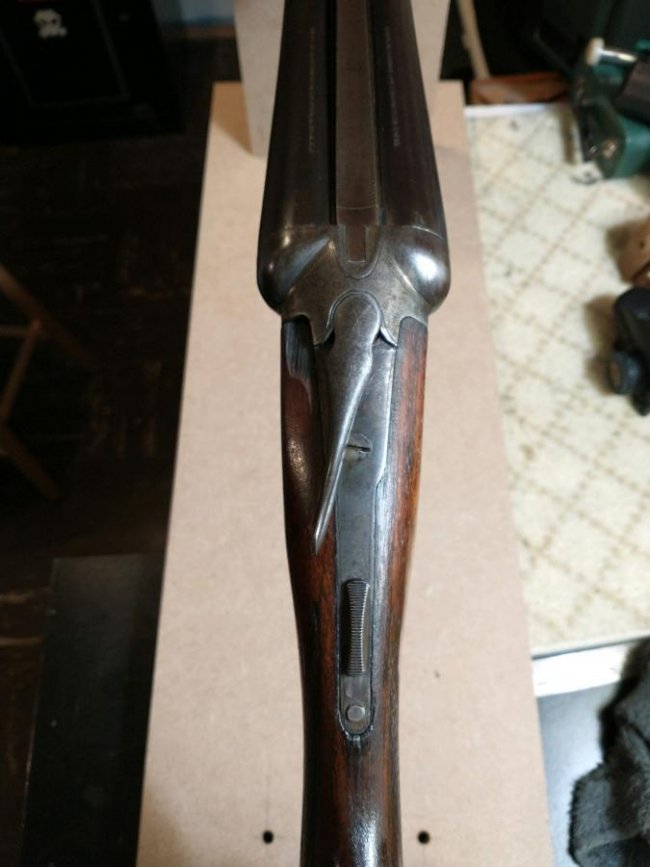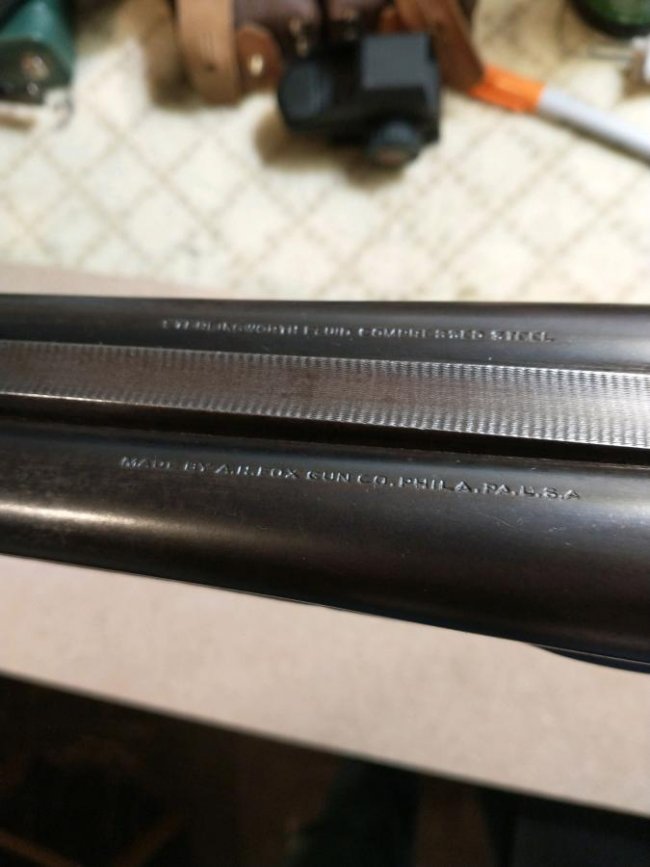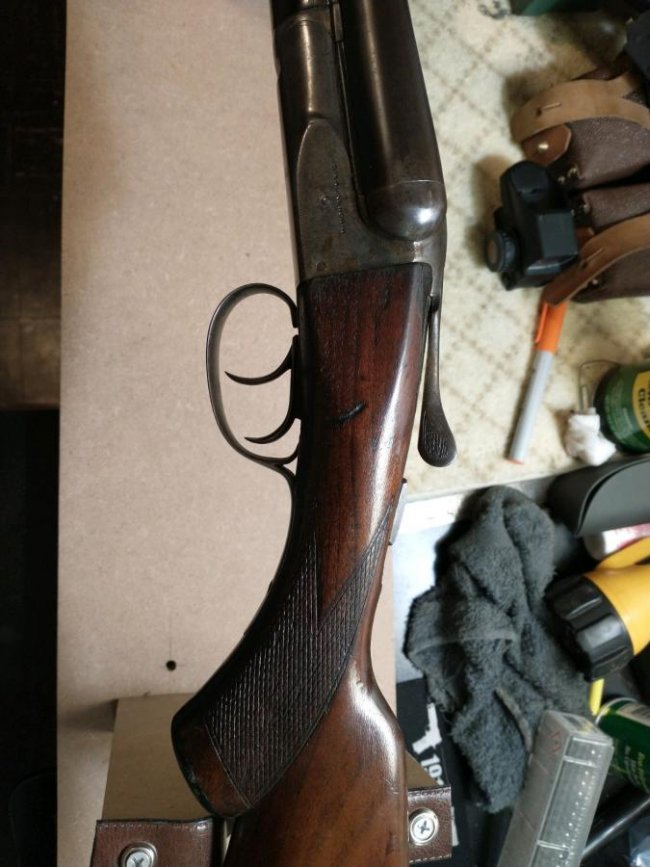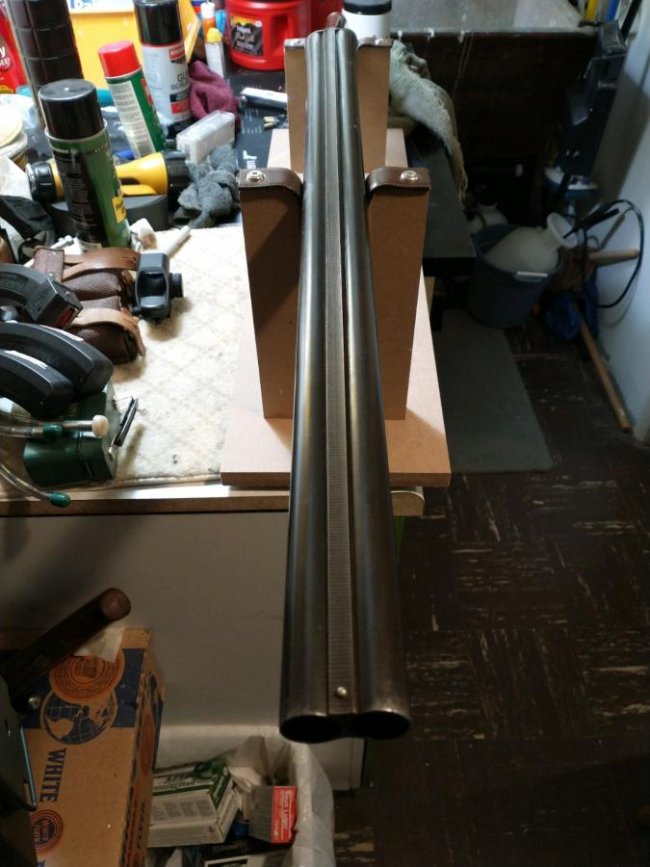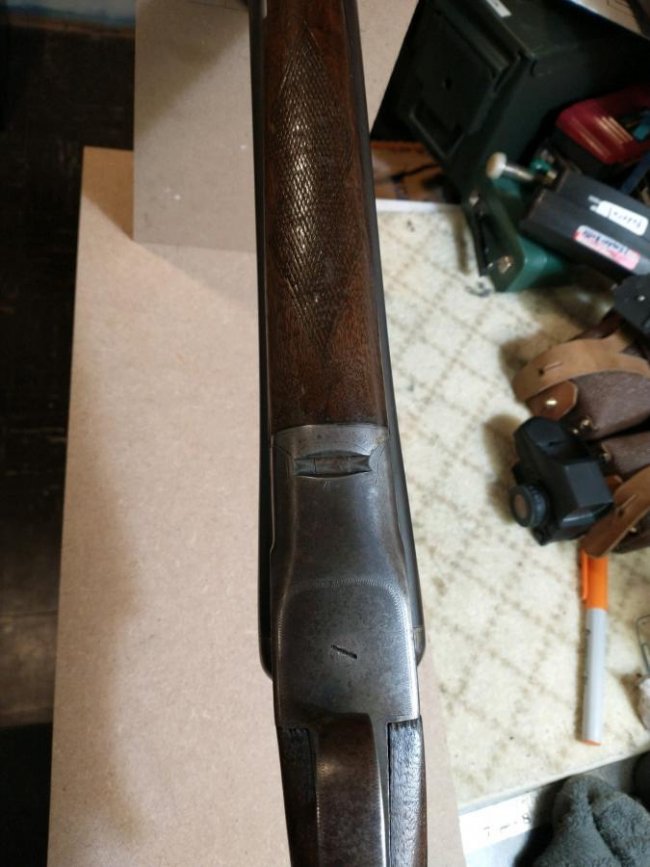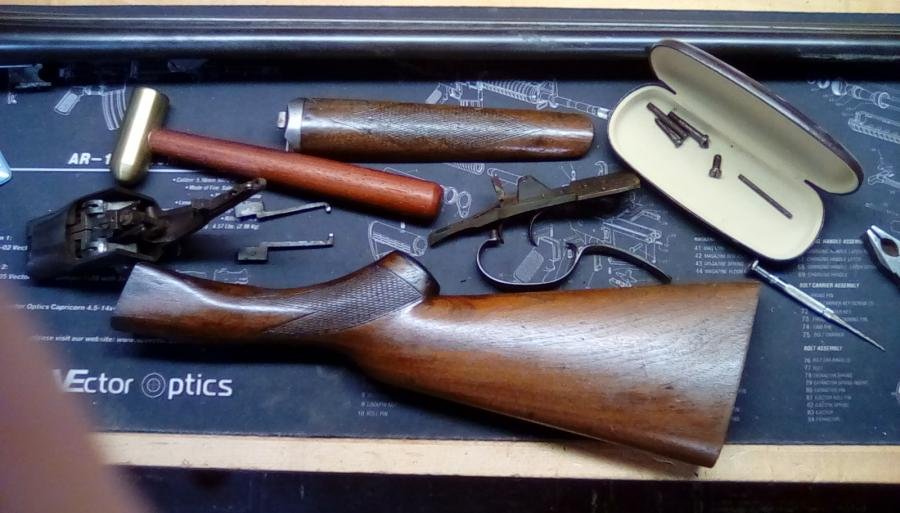Does anybody want to take a stab at what this is worth? Ballpark? Its vintage is 1927. The lever is too far to the left indicating some wear and the barrels have a very slight movement when the forearm is off and I try to move the barrels. There is also a chip out of the stock where it meets the barrels. The bores look bright and shiny. 30-inch barrel length. I think it's worth at least $500-600 in this condition. Just want to make sure it's not worth a whole lot more. Prices seem to be all over the place on Gun Broker but not much under $500. for these.
You are using an out of date browser. It may not display this or other websites correctly.
You should upgrade or use an alternative browser.
You should upgrade or use an alternative browser.
AH Fox Sterlingworth value
- Thread starter Neutron
- Start date
The #1 community for Gun Owners of the Northeast
Member Benefits:
No ad networks! Discuss all aspects of firearm ownership Discuss anti-gun legislation Buy, sell, and trade in the classified section Chat with Local gun shops, ranges, trainers & other businesses Discover free outdoor shooting areas View up to date on firearm-related events Share photos & video with other members ...and so much more!
Member Benefits:
Augie
Ultimate Member
Don't know if I've ever seen one with the lever that far to the left, it is very worn. As far as value couple hundred at best.
If someone offers you $200, take it. The cost of adding steel to the lump for lockup and putting the barrels back to face will run you $500 minimum. Re-stocking is easily another $300-$400 if you want the wood to match and the checkering to be correct. Do not fire it in its current state as the lack of lockup can cause the breech to open on firing which can potentially vent gas rearward.
Yikes! Didn't think it was that bad. Thanks for the opinions though.
Shotgun ID & Value : https://www.shotgunworld.com/bbs/viewforum.php?f=5&sid=b72e1d62269d0298af21cfc7943e6fe1
Up,to you whether it’s worth your time to register and secure a username and password but, the site offers so much else, it’s worth it!
This, is from there so, here you are:
Probably you alls best bet for any of these Fox questions is to take them to the A.H. Fox Collectors Association, Inc.'s web site --
AH Fox Collector’s Assoc.: https://www.foxcollectors.com/
And AH Fox Collector’s Forums : http://forum.foxcollectors.com/
The A.H. Fox Gun Co. was founded in 1905. The Sterlingworth was introduced in 1910.
Sterlingworth -- When Ansley H. Fox, was forced to add a lower priced gun to his line of graded Ansley H. Fox guns, in 1910, he didn't want to detract from the A.H. Fox Gun Co. name, so they dummied up "The Sterlingworth Company." The first year’s guns, beginning with serial number 50,000, were marked as being "Made By The Sterlingworth Company, Philadelphia, U.S.A." Actually the first few hundred were marked "Wayne Junction" instead of Philadelphia. They even produced a separate The Sterlingworth Gun Co. catalogue for 1910. These guns were built under the same patents as the graded Ansley H. Fox guns. The main moneysaving features were an American Black Walnut (Juglans nigra) stock as opposed to the more costly European thin shell walnut (Juglans regia) stocks on the graded guns, and the "Sterlingworth Fluid Steel" barrels instead of Krupp Fluid Steel barrels. Workmanship on these early Sterlingworths was generally excellent, better than graded guns from the 1920's and 30's. The early "The Sterlingworth Company" guns had a rounded front for the side panel of the frames. According to my list of observed specimens that was changed to the same pointed profile as the graded guns by #51,301.
In 1911 this field grade gun was added to the A.H. Fox Gun Co. catalogue as the Model 1911. "Model 1911" is stamped in the forearm iron. (A very few graded guns made about this time are stamped Model 1910) The lowest Model 1911 serial number I've recorded is #53,140. All of these early Sterlingworths had a recessed hinge-pin head like Parkers, or Ansley's earlier guns made in Baltimore and the Philadelphia Arms Company A.H. Fox gun. The highest "pin gun" Sterlingworth serial number I've recorded is # 62,244. After that Sterlingworth hinge-pins are dressed smooth like the graded guns. When the small-bores (16- and 20-gauge) were added to the Ansley H. Fox line they were briefly referred to in some flyers as the Model 1912, but I've never seen one so stamped. Graded 20-gauge guns have serial numbers beginning with 200,000 and 20-gauge Sterlingworths 250,000. Graded 16-gauge guns have serial numbers beginning with 300,000 and 16-gauge Sterlingworths 350,000.
Most of the Philadelphia produced S-worths had the word "Sterlingworth" roll stamped on each side of the frame. After production moved to Utica, Savage started using a "Fox-Sterlingworth" roll stamp.
When the Sterlingworth came out in 1910 it had a price of $25. That climbed to $55 by 1919. A.H. Fox Gun Co. reduced the price to $48 in 1922 and again to $36.50 in 1926. Workmanship of course declined. Savage kept the $36.50 price until June 1932 when they upped it to $39.50. On February 10, 1936, they upped the price again to $42.85 (the digits 2 and 8 are transposed in McIntosh's book). On February 1, 1938, Savage tried a price cut and dropped it to $35. February 1, 1939, they upped the price to $44.75. January 2, 1940, up again to $48.50. January 2, 1941, up to $52.65 and June 16 up again to $56.50. January 2, 1942, up again to $64.95.
For $40 Graded or $30 Sterlingworth (last prices I've seen quoted) you can get a factory letter on most any Ansley H. Fox shotgun (Philadelphia or Utica) from Mr. John T. Callahan, 53 Old Quarry Road, Westfield, MA 01085. The information exists on the factory work-order cards, probably 85+% of which still exist. Send him the complete serial number and a check, and he can do the rest. That would tell you the specifications of the gun when it left the factory.
There were more 12-gauge Sterlingworths made than any other Fox double (some 110,000, the great majority with 30- or 28-inch barrels), so unless in exceptionally high condition or with features such as automatic ejectors or factory original 26- or 32-inch barrels, they are about an $800 gun. It is impossible to truly evaluate a gun with out having it in hand, but average 12-gauge Sterlingworths are about $800 guns.
Up,to you whether it’s worth your time to register and secure a username and password but, the site offers so much else, it’s worth it!
This, is from there so, here you are:
Probably you alls best bet for any of these Fox questions is to take them to the A.H. Fox Collectors Association, Inc.'s web site --
AH Fox Collector’s Assoc.: https://www.foxcollectors.com/
And AH Fox Collector’s Forums : http://forum.foxcollectors.com/
The A.H. Fox Gun Co. was founded in 1905. The Sterlingworth was introduced in 1910.
Sterlingworth -- When Ansley H. Fox, was forced to add a lower priced gun to his line of graded Ansley H. Fox guns, in 1910, he didn't want to detract from the A.H. Fox Gun Co. name, so they dummied up "The Sterlingworth Company." The first year’s guns, beginning with serial number 50,000, were marked as being "Made By The Sterlingworth Company, Philadelphia, U.S.A." Actually the first few hundred were marked "Wayne Junction" instead of Philadelphia. They even produced a separate The Sterlingworth Gun Co. catalogue for 1910. These guns were built under the same patents as the graded Ansley H. Fox guns. The main moneysaving features were an American Black Walnut (Juglans nigra) stock as opposed to the more costly European thin shell walnut (Juglans regia) stocks on the graded guns, and the "Sterlingworth Fluid Steel" barrels instead of Krupp Fluid Steel barrels. Workmanship on these early Sterlingworths was generally excellent, better than graded guns from the 1920's and 30's. The early "The Sterlingworth Company" guns had a rounded front for the side panel of the frames. According to my list of observed specimens that was changed to the same pointed profile as the graded guns by #51,301.
In 1911 this field grade gun was added to the A.H. Fox Gun Co. catalogue as the Model 1911. "Model 1911" is stamped in the forearm iron. (A very few graded guns made about this time are stamped Model 1910) The lowest Model 1911 serial number I've recorded is #53,140. All of these early Sterlingworths had a recessed hinge-pin head like Parkers, or Ansley's earlier guns made in Baltimore and the Philadelphia Arms Company A.H. Fox gun. The highest "pin gun" Sterlingworth serial number I've recorded is # 62,244. After that Sterlingworth hinge-pins are dressed smooth like the graded guns. When the small-bores (16- and 20-gauge) were added to the Ansley H. Fox line they were briefly referred to in some flyers as the Model 1912, but I've never seen one so stamped. Graded 20-gauge guns have serial numbers beginning with 200,000 and 20-gauge Sterlingworths 250,000. Graded 16-gauge guns have serial numbers beginning with 300,000 and 16-gauge Sterlingworths 350,000.
Most of the Philadelphia produced S-worths had the word "Sterlingworth" roll stamped on each side of the frame. After production moved to Utica, Savage started using a "Fox-Sterlingworth" roll stamp.
When the Sterlingworth came out in 1910 it had a price of $25. That climbed to $55 by 1919. A.H. Fox Gun Co. reduced the price to $48 in 1922 and again to $36.50 in 1926. Workmanship of course declined. Savage kept the $36.50 price until June 1932 when they upped it to $39.50. On February 10, 1936, they upped the price again to $42.85 (the digits 2 and 8 are transposed in McIntosh's book). On February 1, 1938, Savage tried a price cut and dropped it to $35. February 1, 1939, they upped the price to $44.75. January 2, 1940, up again to $48.50. January 2, 1941, up to $52.65 and June 16 up again to $56.50. January 2, 1942, up again to $64.95.
For $40 Graded or $30 Sterlingworth (last prices I've seen quoted) you can get a factory letter on most any Ansley H. Fox shotgun (Philadelphia or Utica) from Mr. John T. Callahan, 53 Old Quarry Road, Westfield, MA 01085. The information exists on the factory work-order cards, probably 85+% of which still exist. Send him the complete serial number and a check, and he can do the rest. That would tell you the specifications of the gun when it left the factory.
There were more 12-gauge Sterlingworths made than any other Fox double (some 110,000, the great majority with 30- or 28-inch barrels), so unless in exceptionally high condition or with features such as automatic ejectors or factory original 26- or 32-inch barrels, they are about an $800 gun. It is impossible to truly evaluate a gun with out having it in hand, but average 12-gauge Sterlingworths are about $800 guns.
FrankOceanXray
Ultimate Member
- Oct 29, 2008
- 12,036
If it is for sale, I am looking for a wall hanger at the cabin. This would be nice for that.
Biggfoot44
Ultimate Member
- Aug 2, 2009
- 33,173
Restocking ? Did I miss something looking at the pics on a phone ? I saw a well used gun with character , but didn't see significant cracks or major damage , did I miss something ?
Indeed the lever position indicates need for rebuilding . Depending upon the specifics of the other mentioned play , may or may not be in condition to fire a cpl shots just to say you did .
But a $200 wallhanger ? Too many no longer servicable generic hardware store branded guns at that price level . A rebuildable Sterlingworth has got to be worth * something * over a private label Crescent in same shape .
Indeed the lever position indicates need for rebuilding . Depending upon the specifics of the other mentioned play , may or may not be in condition to fire a cpl shots just to say you did .
But a $200 wallhanger ? Too many no longer servicable generic hardware store branded guns at that price level . A rebuildable Sterlingworth has got to be worth * something * over a private label Crescent in same shape .
Doco Overboard
Ultimate Member
Agree probably a couple things that could be done to tighten that thing up without breaking the bank.
Worn out or damaged is different from out of adjustment or needing repair.
Worn out or damaged is different from out of adjustment or needing repair.
It's not a wall hanger yet. I'm going to look into getting it repaired or doing it myself. The stock only has a small chip so there is no need to replace the stock. The main issue is the lever being too far left and I'm going to look into what it would take to correct that. The barrels are fairly tight with only a few thousandths play with the forearm removed. If the lever is brought back into center it may tighten up the barrels.
Doco Overboard
Ultimate Member
One quick and easy test is to make sure the bottom of the barrels(one or the other isn’t interfering with the water table. ( flat spot) directly above or below and behind the hinge.
Soot or smoke them with candle black the re assemble and close the action smartly to see where the spot gets lifted off.
Soot or smoke them with candle black the re assemble and close the action smartly to see where the spot gets lifted off.
- Feb 23, 2013
- 1,234
A.H. Fox actually started making shotguns in Baltimore around 1896 under the name Fox Gun Co. of Balto. Md. I have one of them and it looks exactly like to OP's gun. Less than a 1000 guns were made before the company was sold to the Baltimore Arms Co. and Fox went on the start the Fox Gun Co of Philadelphia.
I believe that he invented the tang safety that you see one this gun.
I believe that he invented the tang safety that you see one this gun.
One quick and easy test is to make sure the bottom of the barrels(one or the other isn’t interfering with the water table. ( flat spot) directly above or below and behind the hinge.
Soot or smoke them with candle black the re assemble and close the action smartly to see where the spot gets lifted off.
For the visual learners out there.
That said, I've never seen a lever that far to the left that didn't need some pretty major work, including adding metal back to the lump, to get it back to form.
OP, that "small chip" in the stock is going to turn into a broken stock quickly if you don't repair with dowels, or replace it. It's usually a sign that the wood as pulled away from the receiver due to shrinkage over time and has been fired without the stock being re-tightened (or the stock HAS been re-tightened, but the shrinking has caused it to rejoin at an odd angle and the user didn't notice or didn't understand the implications). If it was weak up by the tang, it'll be getting weak down lower as well and will start to develop some major structural issues if not addressed.
This is the small chip I was talking about. The rest of the stock looks great. I don't think this will require a dowel or compromise the integrity of the stock.
Hell no it won't, if the action closes tight.... enjoy it or swap it off.
kind of wondering what you will find, I've never seen a lever over that far. It looks more like something got bubba'd then wear, and if it was dirt, I imagine it would have the lever going the other direction
Yep, buildup in the locking recesses and lugs causes the lever to stop over to the right. That's why the really important to check used double-guns at auction or at the LGS by pulling the forend and removing the barrels from the hinge. That way you can see if an unscrupulous seller or consignee has put a thin strip of paper where the lug meets the pin to hinge open. Doing so (putting paper there) on a gun that is off-face or with very poor lockup, will make it feel solid and push the lever to the right making the uninitiated more likely to buy it thinking it's in better shape than it actually is.
I always pull forends, unhook the barrels, tap each barrel while it's hanging from the lump on my finger with a bic pin or similar to hear if it rings or *thuds* (lets you know if the rib is loose anywhere), pop the barrels back on and give it a shake with the forend off to see if there's any play. Check the hinge for dirt, excessive buildup, or paper, and snap it all back together and see where the lever sits. I'll then check the fit of the stock to the receiver to see if it's ridden up or not, and look for cracks, etc. Checking bores, firing pins, etc. as well as I go through everything.
Wall Hanger
I have a Belgian double hammer that would make a great wall hanger. It's engraved and all. I'll never try to shoot it, Damascus barrels. It can be had for $100. Let me know. AH fox is cooler than a Belgian no name but hey. Price is negotiable
If it is for sale, I am looking for a wall hanger at the cabin. This would be nice for that.
I have a Belgian double hammer that would make a great wall hanger. It's engraved and all. I'll never try to shoot it, Damascus barrels. It can be had for $100. Let me know. AH fox is cooler than a Belgian no name but hey. Price is negotiable
Doco Overboard
Ultimate Member
Stock is chipped from the wood being subjected to recoil and the muzzle flipping up while being leveraged against the rear of the action. Rotational force oil and close fitting wood. You can chisel out square and replace with a larger piece of like wood and carefully make the excess off as you go. Selection and preparation of the repair wood will dictate the cleanliness of the repair and how hard it is to see. Make your piece from scrap after cutting into it to get the grain right. I would use that premium tite-bond glue or mortise the stock and repair piece the acra gel it with black dye.
Before you go full tilt replacing the hinge pin, determining which way the barrels move- either side to side or to front to back will help determine what sort of repair needs to be done.
Earlier on I described smoking the bottom of the barrel which will give indication if the bottom of the barrel lump and water table are out of alignment from the barrels contacting the action table before they are fully locked up. If that's the case you can carefully address the offending area down with a smooth file. Your also checking to see if the barrel lug interferes with the receiving portion of the frame either on the left or right side. Dress down carefully areas where interference is occurring. Once you determined the barrel lump and action table are level, LEVEL here, you very well may discover wear at the hing pin is evident.
The first part of play to deal with is the front and back.
Cheap and dirty way is to peen the semi-circular cut out from the inner portion of the barrel lug. Dont peen the outside of the cutout or you'll be right back where your at in short order. Peen from farther inside the semi circle with the lug supported squarely on a flat steel block captured in a vise. Cribbing up the barrel its entire length will be a definite plus so the lug doesn't warp break or crack. Do one side and then the other evenly by turning the barrels over and working carefully. No sense in overdoing it or you'll be removing metal that you just migrated over. Steady as you go evenly, take the time to improve your rigging /cribbing as necessary. Flat Flat Flat. Make sure steel block is Flat, Flat , Flat! Dress off the sides so the lug fits into the frame smartly. Not too much not to little you adjust to keep it straight. You'll notice in Ole Jacks video he mentions and demonstrates replacing the forearm when checking your work. That will need to be done as your fitting progresses.
Next you will want to address the up and down movement. This can be accomplished by peening the locking lug the very same way the semi circular notch was addressed but in a very slightly different manner. With your lock bolt in good condition peen around the locking notch in the rear end of the barrel lug and just around the lower inner corner drawing the metal out just as before but without battering the edges of the notch all to hell. Not close to the edge, you want to migrate a large mass of metal over not the edge. Smooth up your work with a small sharp file as you go making sure there is no interference with the frame slot.
If that doesn't work you can squeeze the lug together, with one caveat and that is by placing steel slugs inside the chamber that are made to look just like shells but with a little closer fit and grease them. Also at the top of the barrels at the rear, grind out a thick piece of brass or soft steel that straddles the rib where the barrels are captured in a heavy vise so the lug can bear against the vise jaw. Barrels vertical, gently squeeze to close that notch very carefully, in a heavy vise. If you cannot get the lever to return to straight or nearly back towards center your going to have to replace or fab up the one you have.
The right way to do the lug is to weld up the lug and then re-cut or make it bigger and fit a piece of hardened steel into a tongue through he lug and then just drill and pin it.
Thats what a Parker looks like when it's put together if you have the chance to look at one closely. Your shotgun may already be like that which means your ahead of the game already.
You'll know you have it right by doing a shake test. Hold the barrel and shake them like your trying whip a jump rope. You'll see all the movement and slop in the joining. Up down in out grasping the stock and barrels to determine movement. You can see and feel as your work progresses.
More than likely you may be able to tighten it up do some shooting and have some fun at the same time.
Just don't break it over your knee or flop the action open one handed all the time as you gaze out across the hedge row holding two shells in between your fingers like John Taylor on an African pea cock hunt.
If all that doesn't work, You'll have to get a new pin banged into it and that's not as easy as Ole Jack makes it look but hopefully you wont have to.
Before you go full tilt replacing the hinge pin, determining which way the barrels move- either side to side or to front to back will help determine what sort of repair needs to be done.
Earlier on I described smoking the bottom of the barrel which will give indication if the bottom of the barrel lump and water table are out of alignment from the barrels contacting the action table before they are fully locked up. If that's the case you can carefully address the offending area down with a smooth file. Your also checking to see if the barrel lug interferes with the receiving portion of the frame either on the left or right side. Dress down carefully areas where interference is occurring. Once you determined the barrel lump and action table are level, LEVEL here, you very well may discover wear at the hing pin is evident.
The first part of play to deal with is the front and back.
Cheap and dirty way is to peen the semi-circular cut out from the inner portion of the barrel lug. Dont peen the outside of the cutout or you'll be right back where your at in short order. Peen from farther inside the semi circle with the lug supported squarely on a flat steel block captured in a vise. Cribbing up the barrel its entire length will be a definite plus so the lug doesn't warp break or crack. Do one side and then the other evenly by turning the barrels over and working carefully. No sense in overdoing it or you'll be removing metal that you just migrated over. Steady as you go evenly, take the time to improve your rigging /cribbing as necessary. Flat Flat Flat. Make sure steel block is Flat, Flat , Flat! Dress off the sides so the lug fits into the frame smartly. Not too much not to little you adjust to keep it straight. You'll notice in Ole Jacks video he mentions and demonstrates replacing the forearm when checking your work. That will need to be done as your fitting progresses.
Next you will want to address the up and down movement. This can be accomplished by peening the locking lug the very same way the semi circular notch was addressed but in a very slightly different manner. With your lock bolt in good condition peen around the locking notch in the rear end of the barrel lug and just around the lower inner corner drawing the metal out just as before but without battering the edges of the notch all to hell. Not close to the edge, you want to migrate a large mass of metal over not the edge. Smooth up your work with a small sharp file as you go making sure there is no interference with the frame slot.
If that doesn't work you can squeeze the lug together, with one caveat and that is by placing steel slugs inside the chamber that are made to look just like shells but with a little closer fit and grease them. Also at the top of the barrels at the rear, grind out a thick piece of brass or soft steel that straddles the rib where the barrels are captured in a heavy vise so the lug can bear against the vise jaw. Barrels vertical, gently squeeze to close that notch very carefully, in a heavy vise. If you cannot get the lever to return to straight or nearly back towards center your going to have to replace or fab up the one you have.
The right way to do the lug is to weld up the lug and then re-cut or make it bigger and fit a piece of hardened steel into a tongue through he lug and then just drill and pin it.
Thats what a Parker looks like when it's put together if you have the chance to look at one closely. Your shotgun may already be like that which means your ahead of the game already.
You'll know you have it right by doing a shake test. Hold the barrel and shake them like your trying whip a jump rope. You'll see all the movement and slop in the joining. Up down in out grasping the stock and barrels to determine movement. You can see and feel as your work progresses.
More than likely you may be able to tighten it up do some shooting and have some fun at the same time.
Just don't break it over your knee or flop the action open one handed all the time as you gaze out across the hedge row holding two shells in between your fingers like John Taylor on an African pea cock hunt.
If all that doesn't work, You'll have to get a new pin banged into it and that's not as easy as Ole Jack makes it look but hopefully you wont have to.
Augie
Ultimate Member
This may help some, my gunsmith detailed the restoration of my Fox XE and it shows the weak areas with old Fox wood. The trigger box area is prone to cracking, the tang acts as a wedge splitting the stock.
There are many other Fox repairs and custom Fox guns in the blog that may help, little heads up, don't email him asking for advice.
https://vicknairgunsmithing.blogspot.com/2015/12/restoration-of-fox-xe-grade.html
There are many other Fox repairs and custom Fox guns in the blog that may help, little heads up, don't email him asking for advice.
https://vicknairgunsmithing.blogspot.com/2015/12/restoration-of-fox-xe-grade.html
Users who are viewing this thread
Total: 2 (members: 0, guests: 2)
Forum statistics
Latest threads
-
-
-
Just want to thank the extremely awesome folks at Tyler Firearms (1 Viewer)
- Started by GenoBluzGtr
- Replies: 4
-
-
Clearance Liqui Moly Motorbike 4T SAE 15W-50 Street | Full Synthetic Motor Oil | 4 Liter
- Started by mpollan1
- Replies: 3
-
-

